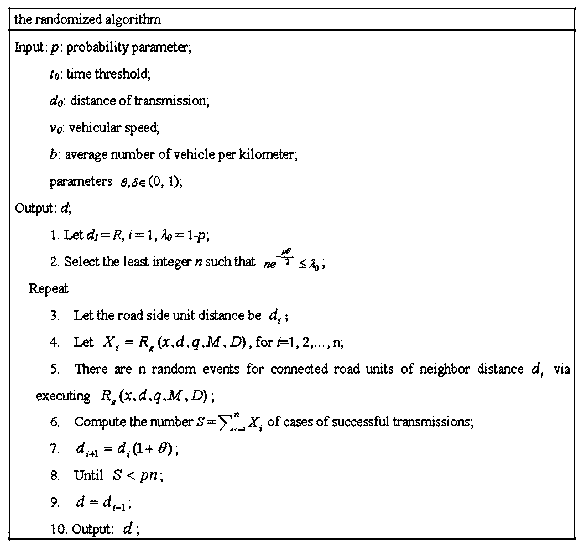Randomized road side unit deployment algorithm
A node deployment and algorithm technology, applied in the field of random roadside node deployment algorithms, can solve problems such as lack of generality, and achieve the effects of improving the probability of messages, high execution efficiency, and simple methods
- Summary
- Abstract
- Description
- Claims
- Application Information
AI Technical Summary
Problems solved by technology
Method used
Image
Examples
Embodiment Construction
[0024] A random roadside node deployment algorithm, such as figure 1 , figure 2 shown, including the following steps:
[0025] Step (1) makes each RSU have unique ID, define function g: if ID is two RSUs of x and y are connected, if and only if g(x)=g(y);
[0026] Step (2) If all RSUs are wired, then for any RSU, its g c (x)=1, x is the ID of the RSU;
[0027] Step (3) If the RSU is not wired, use g u (x) represents its connected topology, and x is the ID of the RSU;
[0028] Step (4) defines M as a highway system, which contains all the attributes of a highway; such as lanes in two directions, the average density of vehicle nodes in the highway is b, and the speed of the vehicle is in [v 1 ,v 2 ] within the range, the maximum wireless transmission range of the vehicle is R, etc.;
[0029] Step (5) defines R g (x, d, q, M, D) represents a random event in the expressway; wherein, x is the ID of the RSU, d is the distance from the random event to the RSU (ID=x), and q i...
PUM
 Login to View More
Login to View More Abstract
Description
Claims
Application Information
 Login to View More
Login to View More - R&D
- Intellectual Property
- Life Sciences
- Materials
- Tech Scout
- Unparalleled Data Quality
- Higher Quality Content
- 60% Fewer Hallucinations
Browse by: Latest US Patents, China's latest patents, Technical Efficacy Thesaurus, Application Domain, Technology Topic, Popular Technical Reports.
© 2025 PatSnap. All rights reserved.Legal|Privacy policy|Modern Slavery Act Transparency Statement|Sitemap|About US| Contact US: help@patsnap.com


